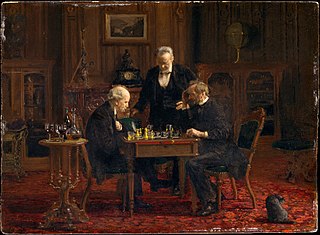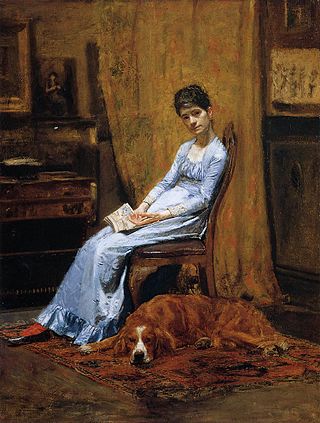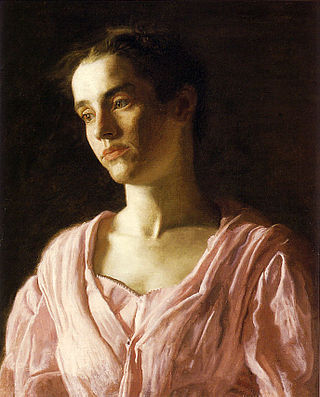
Thomas Cowperthwait Eakins was an American realist painter, photographer, sculptor, and fine arts educator. He is widely acknowledged to be one of the most important American artists.

The Chess Players is an 1876 genre painting by Thomas Eakins, Goodrich catalogue #96. It is in the collection of the Metropolitan Museum of Art, in New York.

Raphael Zalman Soyer was a Russian-born American painter, draftsman, and printmaker. Soyer was referred to as an American scene painter. He is identified as a Social Realist because of his interest in men and women viewed in contemporary settings which included the streets, subways, salons and artists' studios of New York City. He also wrote several books on his life and art.

The Swimming Hole is an 1884–85 painting by the American artist Thomas Eakins (1844–1916), Goodrich catalog #190, in the collection of the Amon Carter Museum of American Art in Fort Worth, Texas. Executed in oil on canvas, it depicts six men swimming naked in a lake, and is considered a masterpiece of American painting. According to art historian Doreen Bolger it is "perhaps Eakins' most accomplished rendition of the nude figure", and has been called "the most finely designed of all his outdoor pictures". Since the Renaissance, the human body has been considered both the basis of artists' training and the most challenging subject to depict in art, and the nude was the centerpiece of Eakins' teaching program at the Pennsylvania Academy of the Fine Arts. For Eakins, this picture was an opportunity to display his mastery of the human form.

The Concert Singer is a painting by Thomas Eakins (1844–1916), depicting the singer Weda Cook (1867–1937). The work, commenced in 1890 and completed in 1892, was Eakins's first full-length portrait of a woman. It is now in the Philadelphia Museum of Art.

Miss Amelia Van Buren or Portrait of Amelia C. Van Buren is a c. 1891 painting by the American artist Thomas Eakins (1844–1916), now in The Phillips Collection. It depicts Amelia Van Buren, an artist who studied with Eakins, and was called "one of his most gifted pupils." The painting is considered one of Eakins's finest works.

Salutat is an 1898 painting by Thomas Eakins (1844–1916). Based on a real-life boxing match that occurred in 1898, the work depicts a boxer waving to the crowd after the match. According to Eakins' biographer Lloyd Goodrich, Salutat is "one of Eakins' finest achievements in figure-painting." The painting's title is Latin for "He greets" or "He salutes."

The Thinker: Portrait of Louis N. Kenton is an oil painting of 1900 by the American artist Thomas Eakins. It is a depiction of the artist's brother-in-law, Louis N. Kenton (1865-1947), and it has been called "one of Eakins's most memorable portraits". The painting is one of a series of life size standing male portraits painted late in Eakins's career.

William Rush and His Model is the collective name given to several paintings by Thomas Eakins, one set from 1876–77 and the other from 1908. These works depict the American wood sculptor William Rush in 1808, carving his statue Water Nymph and Bittern for a fountain at Philadelphia's first waterworks. The water nymph is an allegorical figure representing the Schuylkill River, which provided the city's drinking water, and on her shoulder is a bittern, a native waterbird related to the heron. Hence, these Eakins works are also known as William Rush Carving His Allegorical Figure of the Schuylkill River.

Susan Hannah Eakins was an American painter and photographer. Her works were first shown at the Pennsylvania Academy of the Fine Arts, where she was a student. She won the Mary Smith Prize there in 1879 and the Charles Toppan prize in 1882.

Wrestlers is a name shared by three closely related 1899 paintings by American artist Thomas Eakins,. The Los Angeles County Museum of Art (LACMA) owns the finished painting (G-317), and the oil sketch (G-318). The Philadelphia Museum of Art (PMA) owns a slightly smaller unfinished version (G-319). All three works depict a pair of nearly naked men engaged in a wrestling match. The setting for the finished painting is the Quaker City Barge Club (defunct), which once stood on Philadelphia's Boathouse Row.

Portrait of Leslie W. Miller is a 1901 painting by Thomas Eakins, Goodrich catalogue #348. It is in the permanent collection of the Philadelphia Museum of Art.

Amelia C. Van Buren was an American photographer. A noted portrait photographer, she was a student of Thomas Eakins, and the subject of his c. 1891 painting Miss Amelia Van Buren, regarded as one of his finest works.

Portrait of Mary Adeline Williams is the title given to two separate oil on canvas paintings by Thomas Eakins, each depicting Mary Adeline Williams (1853–1941), known familiarly to the Eakins family as "Addie". The first painting, now in the Art Institute of Chicago, was completed in 1899, and portrays the subject with a serious demeanor. The second portrait, in the Philadelphia Museum of Art, was painted in 1900, and is more emotionally expressive. The contrast between the paintings has been called "Perhaps the most famous example of Eakins's transforming a sitter dramatically while maintaining the effect of severe realism."

Portrait of Maud Cook is an 1895 painting by the American artist Thomas Eakins, Goodrich catalogue #279. It is in the collection of the Yale University Art Gallery.

Frank Benton Ashley Linton was an American portrait-painter and teacher. He was a student of Thomas Eakins, studied the École des Beaux-Arts, and won a bronze medal at the 1927 Salon Nationale in Paris. Likely a closeted gay man, he lived with pianist Samuel Meyers for more than thirty years.

The conservation-restoration of Thomas Eakins' The Gross Clinic refers to the on-going conservation-restoration treatments of American painter Thomas Eakins' 1875 painting The Gross Clinic throughout the 20th and 21st centuries. These treatments are a testament to the changing methodologies undertaken in the field of paintings conservation.

Elizabeth Macdowell Kenton (1858–1953) was an American artist known for her figure paintings and portraits. She was also a photographer.

Archbishop William Henry Elder is a 1903 oil portrait by the American artist Thomas Eakins depicting the Archbishop of Cincinnati William Henry Elder, one of a series of portraits of Catholic clergy Eakins undertook late in his career. In this psychologically probing portrait, Eakins depicts the stoic Elder, frail but still imposing at 84, confronting his own mortality.




















